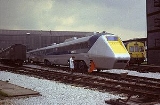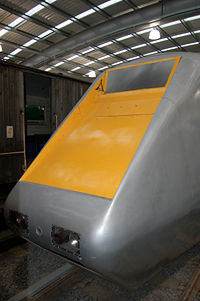
British Rail APT-E
Encyclopedia

Advanced Passenger Train
The Advanced Passenger Train was an experimental tilting High Speed Train developed by British Rail during the 1970s and early 1980s....
tilting train
Tilting train
A tilting train is a train that has a mechanism enabling increased speed on regular rail tracks. As a train rounds a curve at speed, objects inside the train experience centrifugal force. This can cause packages to slide about or seated passengers to feel squashed by the outboard armrest due to...
unit. It was powered by gas turbines
Gas turbine-electric locomotive
A gas turbine - electric locomotive, or GTEL, is a locomotive that uses a gas turbine to drive an electric generator or alternator. The electric current thus produced is used to power traction motors. This type of locomotive was first experimented with during the Second World War, but reached its...
, the only multiple unit
Multiple unit
The term multiple unit or MU is used to describe a self-propelled carriages capable of coupling with other units of the same or similar type and still being controlled from one driving cab. The term is commonly used to denote passenger trainsets consisting of more than one carriage...
so powered that was used by British Rail
British Rail
British Railways , which from 1965 traded as British Rail, was the operator of most of the rail transport in Great Britain between 1948 and 1997. It was formed from the nationalisation of the "Big Four" British railway companies and lasted until the gradual privatisation of British Rail, in stages...
. The APT-E consisted of two driving power cars (PC1 and 2) and two trailer cars (TC1 and 2). Each power car was equipped with four Leyland 350 gas turbines (and a fifth for auxiliary power supplies), these initially produced 300 HP each but were progressively uprated to 330 HP. Two GEC 253AY nose suspended traction motors provided the traction on the leading bogies. The vehicles were manufactured from aluminium, approx 70 ft (21.3 m) with articulated bogies between them.
The APT-E made its first run on July 25, 1972 from Derby to Duffield and was immediately 'blacked' by the drivers' union ASLEF, due to concerns that the single driver's seat preempted ongoing negotiations about the single-manning of trains. It was over twelve months before it ran again on the main line in August 1973.
The prototype was eventually tried out on the Great Western Main Line
Great Western Main Line
The Great Western Main Line is a main line railway in Great Britain that runs westwards from London Paddington station to the west of England and South Wales. The core Great Western Main Line runs from London Paddington to Temple Meads railway station in Bristol. A major branch of the Great...
, nicknamed Brunel's billiard table, and achieved a new British railway speed record when on 10 August 1975 it hit 152.3 mile per hour whilst on test with the Western Region
Western Region of British Railways
The Western Region was a region of British Railways from 1948. The region ceased to be an operating unit in its own right in the 1980s and was wound up at the end of 1992...
between Swindon and Reading. It was also tested extensively on the Midland Main Line
Midland Main Line
The Midland Main Line is a major railway route in the United Kingdom, part of the British railway system.The present-day line links London St...
out of London St. Pancras and on the Old Dalby test track, where in January 1976 it attained a speed of 143.6 mile per hour.
The unit was only intended for testing and was never used in ordinary public service, although it did carry office staff and the occasional dignitaries on trial runs. When its period of testing was complete, in June 1976, it was sent to the National Railway Museum
National Railway Museum
The National Railway Museum is a museum in York forming part of the British National Museum of Science and Industry and telling the story of rail transport in Britain and its impact on society. It has won many awards, including the European Museum of the Year Award in 2001...
, York
York
York is a walled city, situated at the confluence of the Rivers Ouse and Foss in North Yorkshire, England. The city has a rich heritage and has provided the backdrop to major political events throughout much of its two millennia of existence...
for preservation. It is now based at the NRM's Locomotion museum
Shildon Locomotion Museum
Shildon Locomotion Museum is a railway museum in Shildon, County Durham, England. The museum is a branch of the National Railway Museum , which is part of the National Museum of Science and Industry...
in Shildon
Shildon
Shildon is a town in County Durham, in England. It is situated 2 miles to the south east of Bishop Auckland and 11 miles north of Darlington. It is 13 miles away from Durham, 23 miles from Sunderland and 23 miles from Newcastle-upon-Tyne...
. When further APT Class 370
British Rail Class 370
British Rail's Class 370 tilting trains, also referred to as APT-P , were the pre-production Advanced Passenger Train units...
units were built, they were powered by 25 kV AC electrification
Railway electrification in Great Britain
Railway electrification in Great Britain started towards of the 19th century. A great range of voltages have been used in the intervening period using both overhead lines and third rails, however the most common standard for mainline services is now 25 kV AC using overhead lines and the...
.
Test Bed Set
The APT-POP (Power-0-Power) set was a rake of three skeletal unpowered carriages used as a test bed for the suspension, tilting and braking systems used by APT units. The 'Power pumps' were only mock-ups, though similar externally to PC1 and PC2 in the APT-E unit minus cabs, and the whole set had to be hauled by a locomotive. Following the abandonment of the APT project, all three carriages were scrapped in 1985. The set was formed as follows:- Number: 975634 - 975636 - 975635
- Identity: PC3 - Lab 8 - PC4
Sources
- Potter, Stephen (1987). On the Right Lines?: The limits of technological innovation. London: Frances Pinter (Publishers). ISBN 0-86187-580-X.
- Williams, Hugh, (1985). APT: A Promise Unfulfilled. London: Ian Allan Ltd. ISBN 0-7110-1474-4.
- N/A, (1981). Advanced Passenger Train: The official illustrated account of British Rail's revolutionary new 155mph train. Weston-super-Mare: Avon-Anglia Publications & Services. ISBN 0-905466-37-3.
- British Transport FilmsBritish Transport FilmsBritish Transport Films was an organisation set up in 1949 to make documentary films on the general subject of British transport. Its work included internal training films, travelogues , and "industrial films" promoting the progress of Britain's railway...
(1975) E for Experimental republished 2006 by the British Film InstituteBritish Film InstituteThe British Film Institute is a charitable organisation established by Royal Charter to:-Cinemas:The BFI runs the BFI Southbank and IMAX theatre, both located on the south bank of the River Thames in London...
on DVDDVDA DVD is an optical disc storage media format, invented and developed by Philips, Sony, Toshiba, and Panasonic in 1995. DVDs offer higher storage capacity than Compact Discs while having the same dimensions....
as part of British Transport Films Collection (Vol. 3): Running A Railway.

